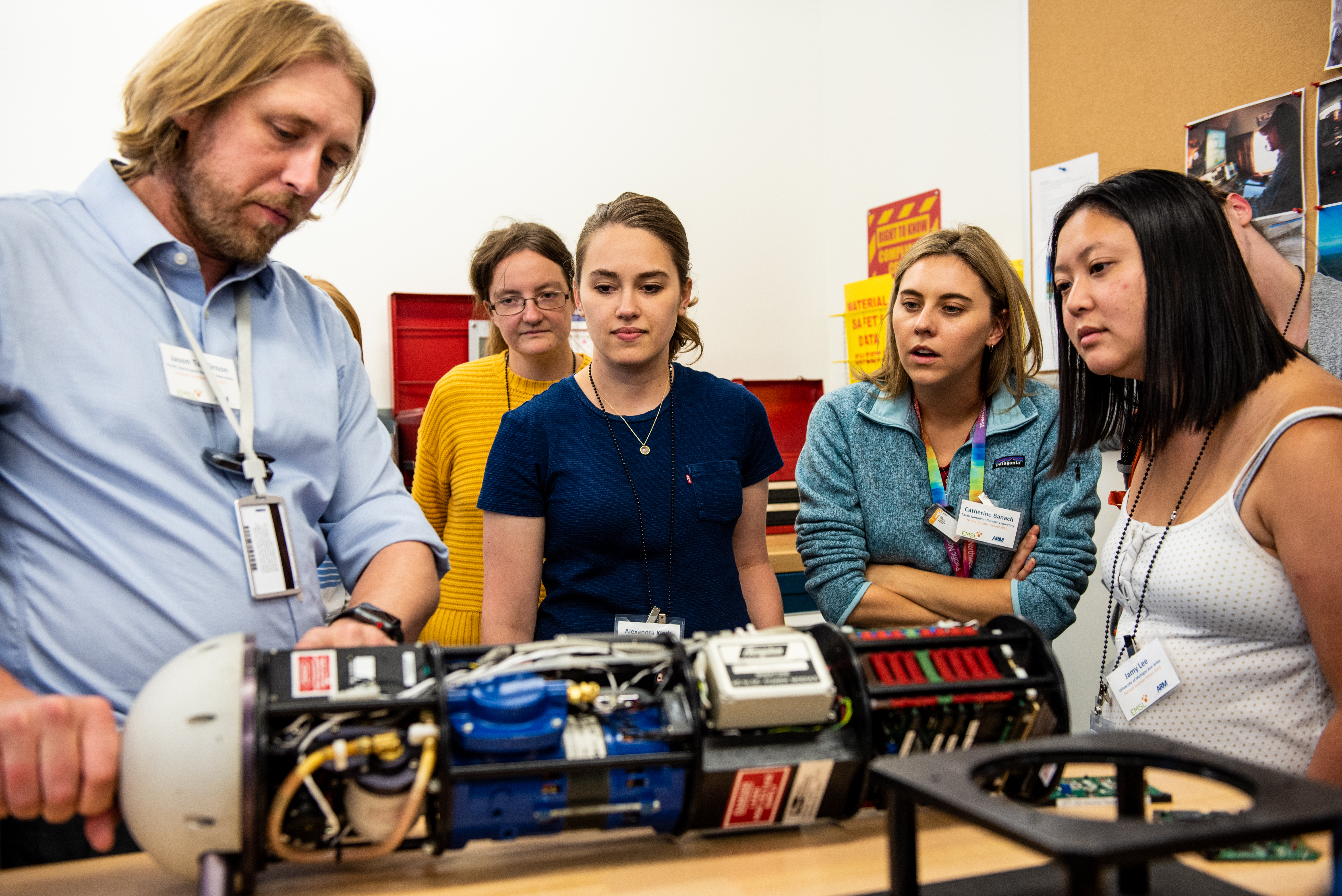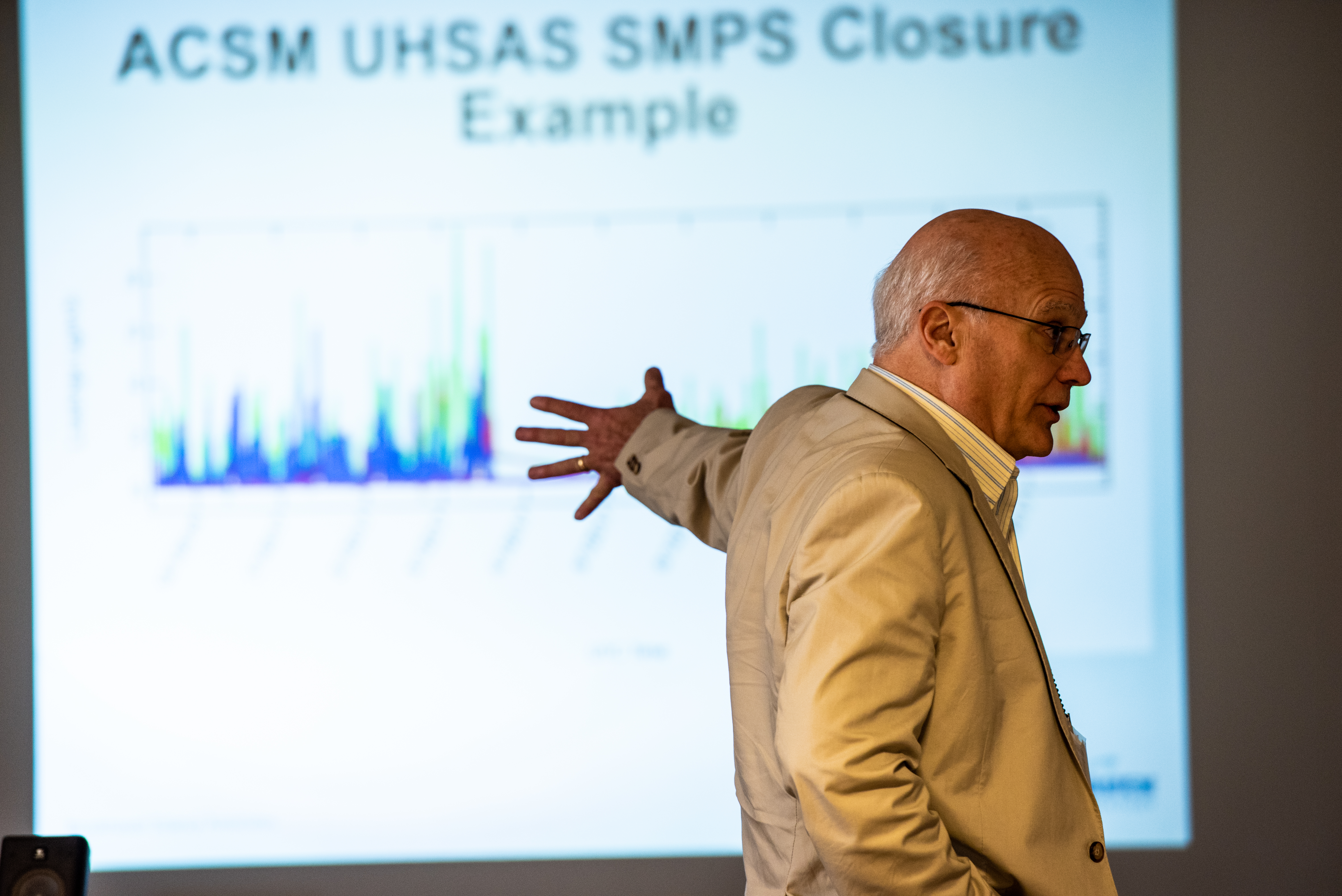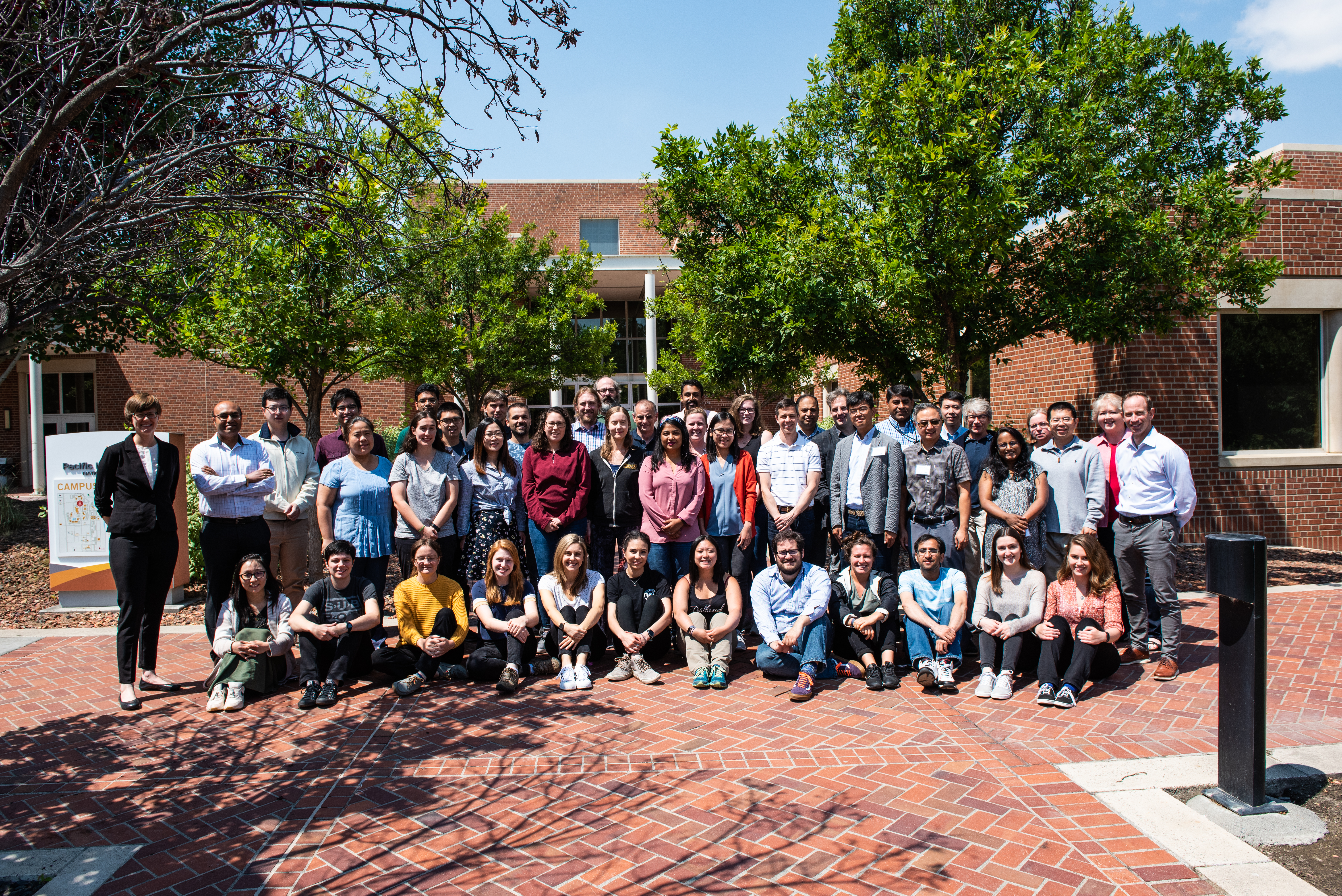ARM-EMSL User Facility Collaboration Drives Successful Aerosol Summer School
Published: 19 August 2019
Future facility users and principal investigators learn about atmospheric particles and their effects on earth systems

Susanne Glienke, a postdoctoral researcher at the Max Planck Institute for Chemistry in Germany, is well acquainted with clouds. During the Aerosol and Cloud Experiments in the Eastern North Atlantic (ACE-ENA) field campaign, she oversaw an instrument called the Holographic Detector for Clouds (HOLODEC). The device mounts on an airplane to take snapshots of the three-dimensional positions of cloud droplets.
While plotting ACE-ENA data, Glienke realized she knew little about the instruments that measure aerosols, the tiny atmospheric particles that help clouds form.
“At some point,” she recalls, “I looked at my HOLODEC data, and as naïve as I was, I thought: ‘Well, we have aerosol instruments. Let’s just try to correlate that,’ and they said, ‘Oh, no, this one doesn’t work in the clouds.’ ”
That experience inspired Glienke to apply for the 2019 Aerosol Summer School co-sponsored by the U.S. Department of Energy’s Atmospheric Radiation Measurement (ARM) user facility, Environmental Molecular Sciences Laboratory (EMSL), and Atmospheric System Research (ASR) program. The school, which explored aerosols and their effects on earth systems, took place July 15 to 19 at Pacific Northwest National Laboratory (PNNL) in Richland, Washington.
ARM and EMSL, both U.S. Department of Energy national scientific user facilities, served as co-hosts. ARM and EMSL staff and users, including several ASR-funded principal investigators, also taught the material.
The aerosol school came a year after ARM’s second Summer Training and Science Applications event on observations and modeling of clouds and precipitation.
“With the ARM workshop and this one, there’s definitely this new element of training a next generation in the science, but also training them in how to engage with these facilities to do the science,” says ARM Technical Director Jim Mather.
Keying In on Aerosol Interest
“It’s really encouraging to see that there are so many people who are interested in getting into this field of research.”
Allison McComiskey, co-chair of ARM’s Aerosol Measurement Science Group
The summer school was the culmination of nearly a year of planning. Mather, John Shilling, ARM aerosol data translator at PNNL, and Allison McComiskey, co-chair of ARM’s Aerosol Measurement Science Group from Brookhaven National Laboratory in New York, helped lead the effort with Nancy Hess, deputy of EMSL science areas, and Alexander Laskin, a former EMSL staff scientist now at Purdue University in Indiana.
Out of 126 applicants, 25 students from the United States, Canada, Germany, and India were chosen for the class. Selected students ranged from a post-bachelor’s research associate to postdocs. They also came from diverse research areas and courses of study, including atmospheric science, chemistry, and engineering.
“It’s really encouraging to see that there are so many people who are interested in getting into this field of research,” says McComiskey. “Even if they don’t end up in research science or doing climate research, there are so many applications that are important.”
McComiskey, who taught a summer school section on remote sensing, wanted to hear how students might combine ARM and EMSL resources in their work. The two user facilities are seeking ways to team up on joint proposal calls, field campaigns, and likely another summer school.
“In general, in research science, we don’t listen to those really early career folks and their ideas enough about what’s going to be important in the future,” says McComiskey.
Observant Pupils

Students spent their mornings in an EMSL conference room, where they absorbed lectures about aerosol properties, theory, measurements, and modeling. They also heard what it is like to lead an ARM field campaign. Larry Berg and Jerome Fast of PNNL and Jian Wang of Washington University in St. Louis (Missouri) shared their experiences proposing, designing, and leading campaigns.
During afternoon demonstrations at EMSL and PNNL’s Atmospheric Measurements Laboratory, the students explored instruments that collect and analyze aerosol samples. They included an environmental chamber operated by Shilling and aircraft measurement probes and mass spectrometers used during ARM field campaigns. Students also worked on aerosol modeling simulations.
The lessons Glienke gleaned from the summer school will serve her well in her next job: caring for cloud probes as a postdoc working in the ARM Aerial Facility at PNNL.
Glienke learned about the formation of aerosols and their chemical composition. She hopes she can better communicate with aerosol researchers to “directly connect clouds and aerosols in my work,” she says.
“That is indeed what I liked about the summer school—the diversity of participants and the variety of viewpoints on the same topic, being able to talk to each other and understanding what the others need and do.”
ARM and ASR Contributors

ARM users and staff and ASR-funded principal investigators who helped plan and/or teach the summer school included:
- Berg, Fast, Mather, Shilling, Susannah Burrows, Duli Chand, Swarup China, Gourihar Kulkarni, Fan Mei (ARM Aerial Facility science manager), ManishKumar Shrivastava, Jason Tomlinson (ARM Aerial Facility engineering manager), Hailong Wang, Rahul Zaveri, and Alla Zelenyuk-Imre, PNNL
- McComiskey, Janek Uin (ARM mentor for Aerosol Observing System instruments), and Tom Watson (ARM instrument mentor for the aerosol chemical speciation monitor), Brookhaven National Laboratory
- Laskin, Purdue University
- Wang, Washington University in St. Louis
- Charlotte Beall, Scripps Institution of Oceanography in California
- Daniel Knopf, Stony Brook University in New York
- Manabu Shiraiwa, University of California, Irvine.
Keep up with the Atmospheric Observer
Updates on ARM news, events, and opportunities delivered to your inbox
ARM User Profile
ARM welcomes users from all institutions and nations. A free ARM user account is needed to access ARM data.


















